
Diamond is a metastable allotrope of carbon, where the carbon atoms are arranged in a variation of the face-centered cubic crystal structure called a diamond lattice. Diamond is less stable than graphite, but the conversion rate from diamond to graphite is negligible at standard conditions. Diamond is renowned as a material with superlative physical qualities, most of which originate from the strong covalent bonding between its atoms. In particular, diamond has the highest hardness and thermal conductivity of any bulk material. Those properties determine the major industrial application of diamond in cutting and polishing tools and the scientific applications in diamond knives and diamond anvil cells.
Most natural diamonds are formed at high temperature and pressure at depths of 140 to 190 kilometers (87 to 118 mi) in the Earth’s mantle. Carbon-containing minerals provide the carbon source, and the growth occurs over periods from 1 billion to 3.3 billion years (25% to 75% of the age of the Earth). Diamonds are brought close to the Earth’s surface through deep volcanic eruptions by a magma, which cools into igneous rocks known as kimberlites and lamproites. Diamonds can also be produced synthetically in a HPHT method which approximately simulates the conditions in the Earth’s mantle. An alternative, and completely different growth technique is chemical vapor deposition (CVD). Several non-diamond materials, which include cubic zirconia and silicon carbide and are often called diamond simulants, resemble diamond in appearance and many properties. Special gemological techniques have been developed to distinguish natural diamonds, synthetic diamonds, and diamond simulants.
A chemically pure and structurally perfect diamond is perfectly transparent with no hue, or color. However, in reality almost no gem-sized natural diamonds are absolutely perfect. The color of a diamond may be affected by chemical impurities and/or structural defects in the crystal lattice. Depending on the hue and intensity of a diamond’s coloration, a diamond’s color can either detract from or enhance its value. For example, most white diamonds are discounted in price when more yellow hue is detectable, while intense pink or blue diamonds (such as the Hope Diamond) can be dramatically more valuable. Of all colored diamonds, red diamonds are the rarest. The Aurora Pyramid of Hope displays a spectacular array of naturally colored diamonds, including red diamonds.
Diamond Colors
Diamonds occur in a variety of colors; steel gray, white, blue, yellow, orange, red, green, pink to purple, brown, and black. Colored diamonds contain interstitial impurities or structural defects that cause the coloration, whilst pure diamonds are perfectly transparent and colorless.
Brown Diamonds
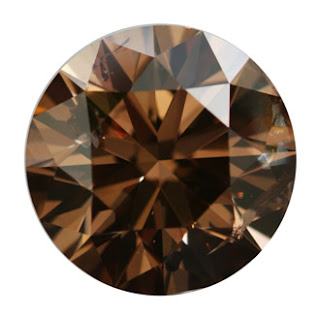
Brown diamonds are the most common color variety of natural diamonds. The brown color makes them less attractive as gemstones because of the reduced glimmer, and most are used for industrial purposes. However, improved marketing programs, especially in Australia and the United States, have resulted in brown diamonds becoming valued as gemstones in recent years and even referred to as chocolate diamonds.
A significant portion of the output of Australian diamond mines is brown stones. A large amount of scientific research has gone into understanding the origin of the brown color. Several causes have been identified, including irradiation treatment, nickel impurities and lattice defects associated with plastic deformation; the latter is considered as the predominant cause, especially in pure diamonds. A high-pressure high-temperature treatment has been developed that heals lattice defects and converts brown diamonds into yellow or even colorless stones.
Orange Diamonds
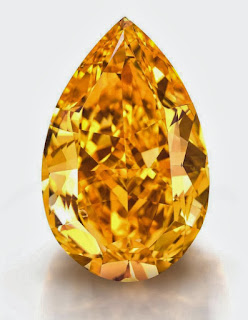
The vast majority of all diamonds contain some nitrogen. In orange diamonds the nitrogen atoms have grouped themselves in a very specific way. This happens during and right after the diamond is formed. These nitrogen arrangements absorb light in the blue and yellow region of the spectrum producing an orange color. Orange Diamonds may contain a brown, yellow or pinkish modifying color.
The majority of orange diamonds come from Africa. The interest in this color surged in 1997 with the auction of the Pumpkin Diamond, so named by the buyer Ronald Winston as it was purchased the day before Halloween. The 5.54 carat vivid orange diamond, was at the time the largest vivid orange diamond ever found.
Yellow Diamonds
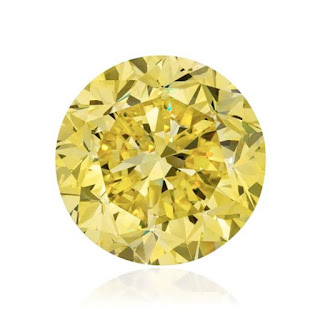
Yellow diamonds the nitrogen atoms have grouped themselves in very specific ways. This happens during and right after the diamond is formed. These nitrogen arrangements absorb light in the blue region of the spectrum producing a yellow color. Yellow diamonds can contain an orange, green or brown modifying color.
The most notably large and intense yellow diamonds have been discovered primarily in South Africa. The Allnatt, a 101ct cushion shape fancy vivid yellow diamond is perhaps the most signifi cant yellow diamond in history, named after its original owner Major Allnatt in the 1950s. One of the largest polished diamonds in the world is the Incomparable, a 407ct internally flawless brownish yellow diamond.
Green Diamonds
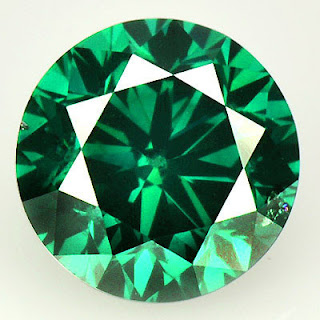
Green diamonds acquire their color after their trip to the earths surface when they rest in the ground near naturally occurring radiation. This radiation pushes into the diamond causing absorption in the red and yellow regions of the spectrum producing a green color. Green Diamonds can contain a yellowish, bluish or grayish modifying color.
Green diamonds are found predominately in regions of Africa and South America. The Dresden Green is the most famous green diamond. Weighing approximately 41 carats, it is often referred to as the cousin of the Hope Diamond for its historical importance. predominately in regions of Africa and South America. The Dresden diamond. Weighing approximately 41 carats, it is often referred to as the cousin of the Hope Diamond.
Blue Diamonds

The bonding of boron to carbon causes absorption in the red, yellow and green parts of the spectrum producing a blue color. Blue Diamonds may contain a gray, violet or greenish modifying color.
The Cullinan mine and Golconda region are the most notable areas where blue diamonds have come from. The most famous blue diamond in history is the 45 carat Hope Diamond. In 2008 The Wittelsbach Diamond, a 35.56 carat ushion-shaped fancy deep blue, was purchased at auction for $24 million. Experts compare this stones color and characteristics to the famed Hope Diamond.
Pink Diamonds

Diamonds become pink when heat and pressure deep within the earth cause the crystal lattice to distort. These distortions cause Pink Diamonds to absorb green light and hence impart a pink color. This can often be seen as in parallel bands within the diamond. Pink Diamonds may be modifi ed by an orange, brown or purplish color.
Pink diamonds can be graded faint, very light, light, fancy light, fancy intense, fancy deep and fancy vivid. And like other hues, the stronger the color, the higher the price tag.
Pink diamonds often feature secondary hues – an additional modifying color. The most common modifying colors are orange, brown and purple.
Natural pink diamonds can be found in Brazil, Russia, Siberia, South Africa, Tanzania and Canada. However, the majority of these breathtaking stones hail from the Argyle Mine in Australia, which is owned by Rio Tinto. The firm’s headquarters is also in Perth, Western Australia.
Here, the finest quality pink diamonds from the Argyle mine are cut and polished before they are sold via an exclusive tender. For proportions and to understand the rarity of pink diamonds, out of every 1 million carats of rough diamonds that the mine produces, just 1 carat is suitable to sell.
Red Diamonds

Red diamonds are extremely rare. Basically they are very strongly and deeply colored pink diamonds, with the same cause of color, crystal distortion. This combination is so rare that most jeweler and diamond dealers have never even seen a natural red diamond. They do not get large with the 5.11 carat Moussiaf Red shield being the largest known red.
Purple Diamonds
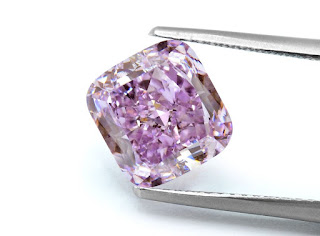
Purple diamonds are very rare. It is believed that they have a similar cause of color as pink diamonds; crystal distortion. They are most often found in Siberia and are generally small in size. There are no historical or famous purple diamonds. This may be due to their inhospitable location. Purple diamonds larger than 5 carats are extremely rare, and their color rarely reaches the intense and vivid color grades.
Violet Diamonds
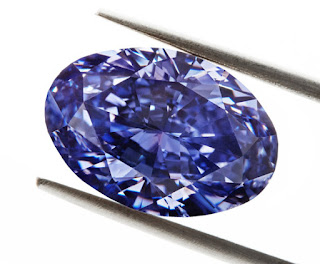
Violet diamonds are very rare. The vast majority come from the Argyle mine, the same mine that most strongly colored pink diamonds are found. Their color is related to Hydrogen, but the exact mechanism is as yet unknown. They are often very small and diamonds greater than 1 carat are extremely rare. Their color usually has a gray component, diamonds of a pure violet color represent less than 10% of all violets. The number of intense and vivid violet diamonds mined each year could be counted on one hand.
Olive Diamonds

Olive diamonds are often confused with green diamonds, but they populate a different and discrete area of color space. Their color is a combination of yellow and green sometimes also a bit of brown or gray. They often come with three colors to describe them such as brownish greenish Yellow, and while this does accurately describe the color olive is a simpler, more concise term. They can range is size from small to large (some are 10+ carats). Occasionally they exhibit a color change when heated or left in the dark, these are known as chameleon diamonds.
Black Diamonds
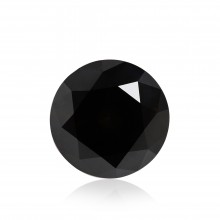
Natural color black diamonds are rare. Their color is due to dark inclusions within the diamond, usually made up of graphite. It is rare that they are large, but the most famous black diamond, the Black Orloff, is 67.50 carats. Usually they are opaque and much of their beauty is the bright, adamantine luster that reflects light off the surface. Often used as melee in fashion jewelry in combination with colorless diamonds black diamonds are becoming very popular.
White Diamonds
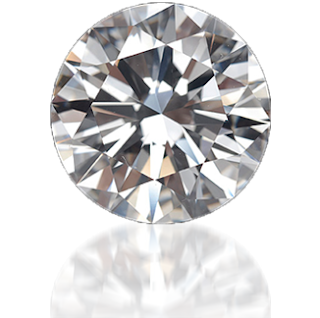
Natural color white diamonds are not colorless, but are actually white. This can often cause confusion as the term is used loosely. A pure white diamond has a translucency or even opacity that makes the diamond white. This is often caused by sub-microscopic inclusions. They occasionally exhibit a weak play of color (similar to opals) called opalescence. These are highly prized among conniseurs.
Gray Diamonds

Gray diamonds are often steely in appearance and to an untrained eye may be hard to distinguish from colorless diamonds. When viewed side-by-side the difference is obvious, a gray diamond is darker than a colorless one. Pure gray diamonds are rare and are frequently described as a masculine color diamond.
Reference:
Wikipedia: Diamond
Wikipedia: Diamond color
Natural Color Diamond Industry Association










